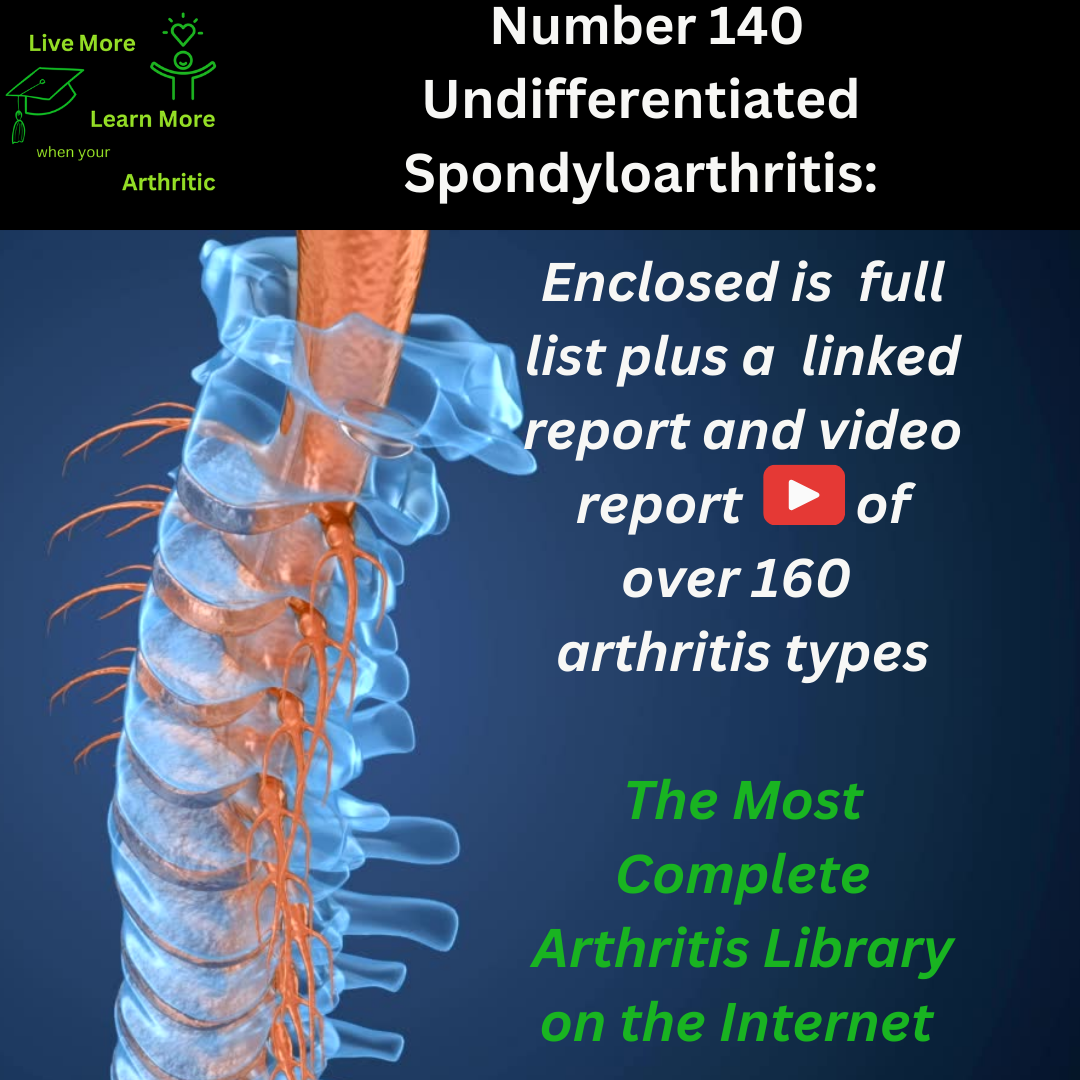
Undifferentiated Spondyloarthritis: Number 140 Type of Arthritis
Understanding Undifferentiated Spondyloarthritis
Undifferentiated Spondyloarthritis, also known as Spondyloarthropathy, is a complex and often misunderstood form of arthritis that falls under the broader category of spondyloarthritis (SpA). Unlike specific types like ankylosing spondylitis or psoriatic arthritis, undifferentiated SpA doesn’t neatly fit into one diagnosis due to its variable symptoms and presentation.
 Overlapping with Other Arthritis Types
Overlapping with Other Arthritis Types
Comorbidity and Overlap: Undifferentiated SpA can overlap with various other forms of arthritis and autoimmune conditions. It often shares features with psoriatic arthritis, reactive arthritis, and inflammatory bowel disease-associated arthritis. This overlap can complicate diagnosis and treatment, requiring a comprehensive evaluation by a rheumatologist.
Inflammatory Nature of Undifferentiated SpA
Inflammation in Undifferentiated SpA: Yes, undifferentiated SpA is considered an inflammatory arthritis. It involves inflammation primarily at the sites where ligaments and tendons attach to bones (entheses), causing pain, stiffness, and swelling in the affected joints.
Affected Body Parts and Joints
Most Affected Areas: Undifferentiated SpA commonly affects the spine, particularly the lower back (sacroiliac joints), leading to stiffness and discomfort. It can also involve peripheral joints like hips, knees, ankles, and shoulders, along with tendons and ligaments.
Symptoms and Limited Range of Motion
Description of Symptoms: Symptoms include chronic back pain and stiffness that worsens with rest and improves with movement. Limited range of motion in the spine and affected joints is common, impacting daily activities and quality of life.
Age of Onset and Lifespan Impact
Onset Age: Undifferentiated SpA often begins in early adulthood, typically between ages 20 to 40. Lifespan Impact: While undifferentiated SpA doesn’t typically shorten lifespan, it can significantly affect quality of life if left untreated or poorly managed.
Autoimmune Nature and Risk Factors
Autoimmune Component: Yes, undifferentiated SpA is believed to have an autoimmune component, where the immune system mistakenly attacks healthy tissues. Risk Factors: Genetic predisposition, family history of SpA, and certain infections may contribute to the development of undifferentiated SpA.
Complications and Swelling
Complications: Potential complications of undifferentiated SpA include joint damage, fusion of spinal vertebrae (ankylosis), eye inflammation (uveitis), and increased risk of cardiovascular disease. Swelling and Inflammation: Swelling (synovitis) is a common feature of undifferentiated SpA, contributing to pain and stiffness in affected joints.
Loss of Range of Motion
Range of Motion Impairment: Chronic inflammation and structural changes in joints and spine can lead to progressive loss of range of motion over time, affecting mobility and flexibility.
Proactive Approach for Improved Quality of Life
Improving Quality of Life: A proactive approach to undifferentiated SpA involves early diagnosis, regular monitoring by a rheumatologist, physical therapy to maintain joint flexibility, exercise, and lifestyle modifications to manage symptoms and reduce inflammation.
Possible Complications and Differences from Primary Arthritis
Complications of Undifferentiated SpA: Complications may include severe joint damage, disability, and decreased mobility if not managed effectively. Differences from Primary Arthritis: Undifferentiated SpA differs from primary arthritis in its variable and overlapping symptoms, making diagnosis and treatment more challenging.
Common Ages Affected and Gender Differences
Age and Gender: Undifferentiated SpA often affects young to middle-aged adults, with no significant gender predominance.
Interconnected Diseases and Conditions
 Interconnected Conditions: Interrelated conditions include psoriasis, inflammatory bowel disease (Crohn’s disease, ulcerative colitis), and reactive arthritis, all of which can share similar inflammatory pathways and genetic risk factors.
Interconnected Conditions: Interrelated conditions include psoriasis, inflammatory bowel disease (Crohn’s disease, ulcerative colitis), and reactive arthritis, all of which can share similar inflammatory pathways and genetic risk factors.
Understanding undifferentiated SpA and its potential overlaps and complications is crucial for early intervention and personalized management to improve outcomes and quality of life for individuals affected by this complex form of arthritis. Regular medical follow-up, lifestyle modifications, and a proactive treatment approach can make a significant difference in managing symptoms and preventing long-term complications.